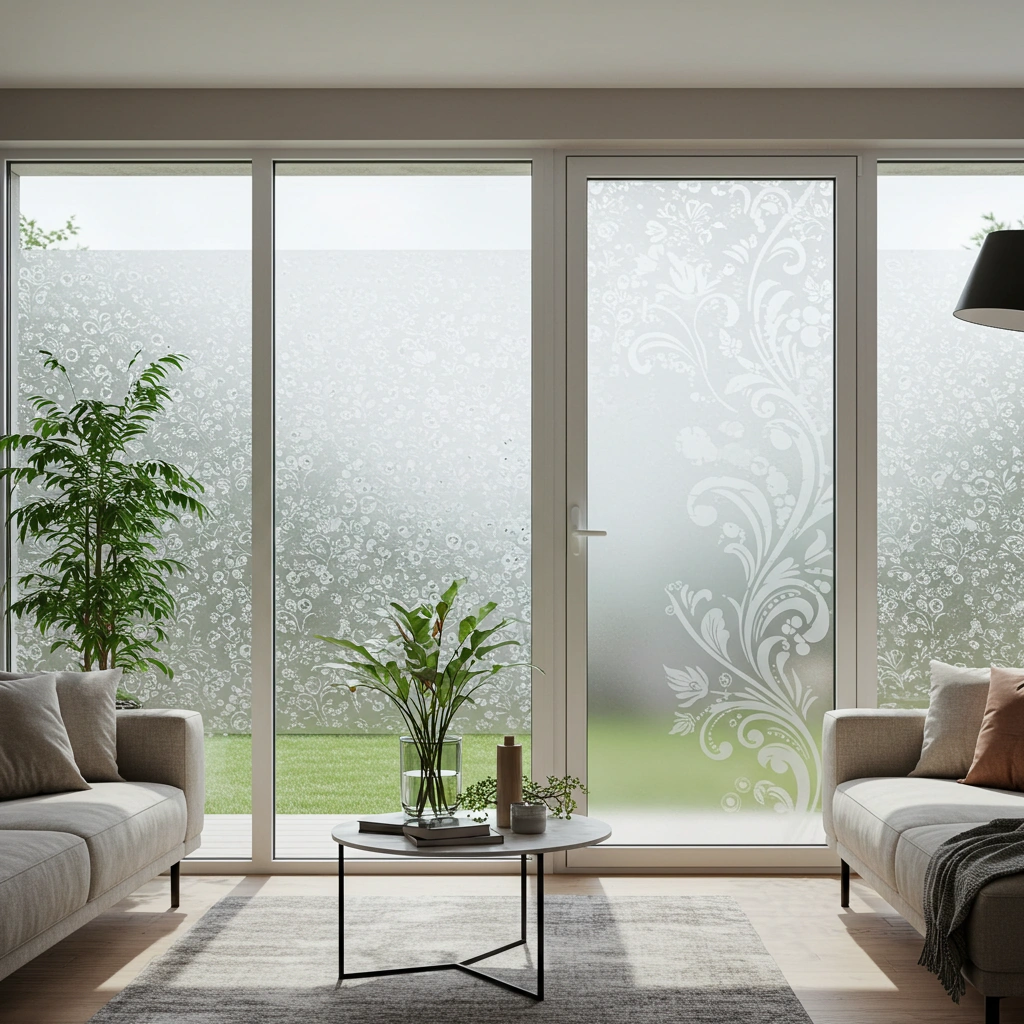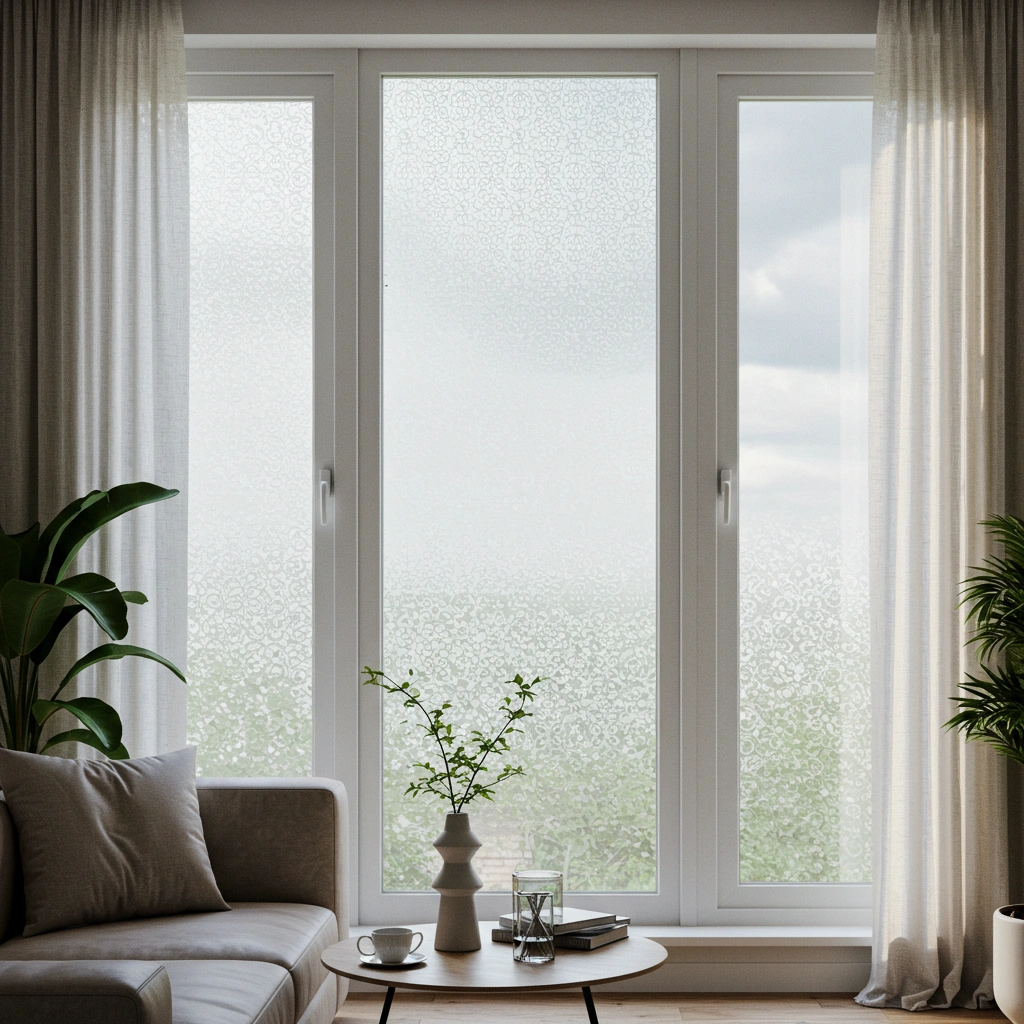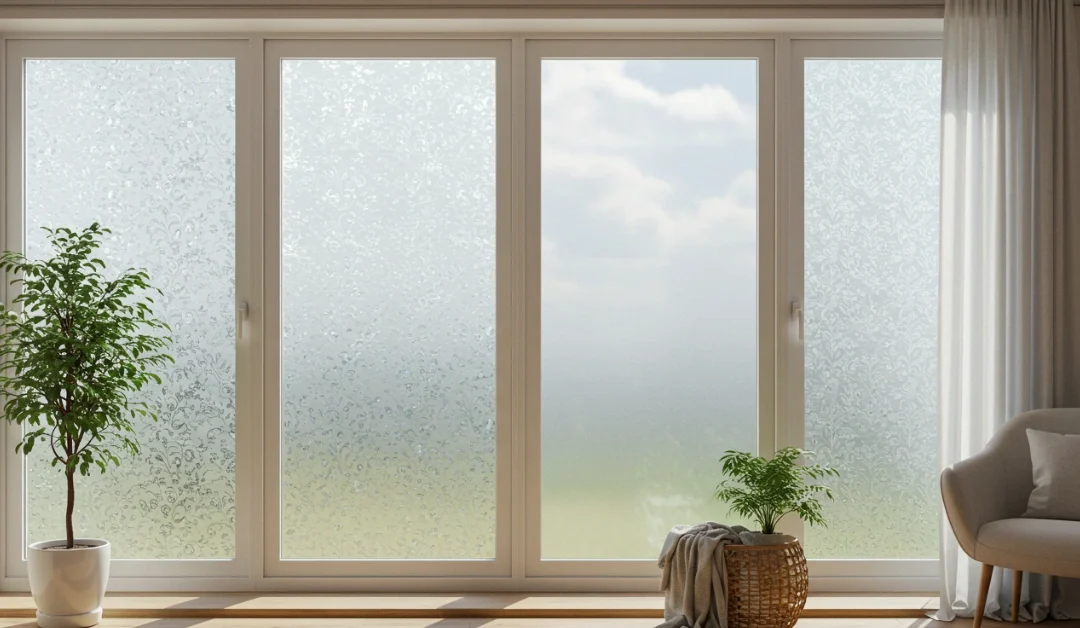Decorative window films are like magic stickers for your glass surfaces. They are applied to windows to make them look prettier, provide privacy, and protect against harmful sunlight. These films come in many styles, such as frosted patterns, stained glass designs, and even custom prints.
They are easy to install, affordable, and perfect for renters or homeowners who want a quick makeover without permanent changes. If you’re tired of plain windows or want to hide an unattractive view, decorative window films might be the solution you’ve been searching for.
1. What Exactly Are Decorative Window Films and How Do They Work?

Decorative window films are thin layers of material, typically made from vinyl or polyester, that are applied directly to glass. They adhere using either adhesive glue or static cling technology. Once installed, they mimic the appearance of etched glass, stained glass, or frosted designs.
These films work by:
- Filtering sunlight: Reducing glare while allowing natural light to pass through.
- Blocking UV rays: Many films are designed to block up to 99% of harmful UV radiation, protecting furniture and flooring from fading.
- Enhancing privacy: Frosted or opaque films prevent outsiders from seeing inside while maintaining brightness indoors.
For more ideas on matching window treatments with interior decor, check out our guide to curtain color for every room.
2. What Types of Decorative Window Films Are Available?
Are Frosted Window Film Designs Right for My Space?
Frosted window films create a translucent, icy effect that softens the light and adds elegance. They are ideal for bathrooms, office partitions, or any area needing privacy without darkness. Popular designs include:
- Geometric patterns: Modern and sharp, perfect for contemporary homes.
- Nature-inspired motifs: Leaf shapes, waves, or floral patterns bring a touch of the outdoors inside.
- Textured finishes: Simulate sandblasted glass for a high-end look.
Frosted films are especially useful in urban areas where neighbors are close.
Do Stained Glass Films Offer the Same Look as Real Stained Glass?
Yes! Stained glass window films replicate the vibrant colors and intricate details of traditional stained glass at a fraction of the cost. These films are made from colored vinyl and can be cut into custom shapes like sunbursts, mandalas, or even family crests.
They are commonly used in:
- Entryways: To create a welcoming focal point.
- Dining rooms: Adding drama and warmth to gatherings.
- Churches or event spaces: For a sacred or celebratory atmosphere.
For a comparison of window treatments, see our post on roller blinds vs. Venetian blinds.
How Can Privacy Window Films Improve My Home or Office?
Privacy films are designed to obscure visibility while letting light in. They come in two main types:
- One-way privacy films: Reflective during the day, preventing outsiders from seeing in while allowing clear visibility from inside.
- Opaque films: Fully block the view, ideal for bathrooms or bedrooms.
These films are often used in apartments, offices, or ground-floor windows where security is a concern.
Can I Customize Adhesive Window Films for Unique Spaces?
Absolutely! Many brands offer custom printing services where you can upload your designs, logos, or text. Custom films are popular for:
- Businesses: Branding storefront windows or office doors.
- Events: Wedding decorations or party themes.
- Personalization: Adding names, quotes, or artwork to home windows.
For renters, removable adhesive films are a game-changer—they leave no residue when taken down.
3. Why Choose Decorative Window Films Over Other Window Treatments?
Do Decorative Window Films Enhance Aesthetic Appeal?
Yes! These films turn ordinary windows into eye-catching features. Unlike curtains or blinds, they don’t require hardware or frequent cleaning. Simply apply and enjoy a polished look.
Tips for matching films with your decor:
- Modern homes: Opt for geometric or minimalist patterns.
- Coastal themes: Use wave or seashell designs.
- Traditional spaces: Stained glass or floral motifs add timeless charm.
Can Decorative Films Provide Privacy Without Blocking Natural Light?
Unlike heavy curtains or solid blinds, decorative films allow light to filter through while obscuring the view. This makes them ideal for:
- Kitchens: Brightening the space without sacrificing privacy.
- Living rooms: Maintaining a connection to the outdoors.
- Home offices: Reducing glare on screens while keeping the room illuminated.
Do These Films Offer UV Protection and Energy Efficiency?
Many decorative window films include UV-blocking layers that protect the skin and prevent furniture from fading. Some films also reduce heat gain by reflecting solar energy, which can lower cooling costs in summer.
For more energy-efficient home upgrades, explore grass cloth vs. peel-and-stick wallpaper.
4. How Do You Apply Frosted Window Film at Home Like a Pro?

Applying decorative window film is a DIY-friendly project. Here’s how to do it right:
- Clean the window: Use a mixture of dish soap and water to remove dust and grease.
- Measure and cut: Lay the film on a flat surface and trim it to fit the window, leaving a 1/8-inch margin.
- Spray and stick: Mist the window with soapy water, peel the film’s backing, and press it onto the glass.
- Squeeze out bubbles: Start from the center and work outward to eliminate wrinkles.
- Trim edges: Use a utility knife to cut around the window frame.
Pro tip: Use a hairdryer to warm the film for easier smoothing.
5. Where Can You Use Decorative Window Films in Different Rooms?
What Are the Best Privacy Films for Bathrooms?
Frosted or opaque films are ideal for bathrooms. Look for moisture-resistant options to avoid peeling. Popular choices include:
- Leaf or fern patterns: Add a spa-like feel.
- Stripes or dots: Simple yet stylish.
For a cohesive look, pair these with ripple fold vs. pinch pleat curtains.
How Can You Add Style to Kitchens and Dining Areas with Films?
In kitchens, use films with food-themed designs (e.g., citrus slices or herb patterns) or geometric shapes for a modern vibe. Dining areas benefit from stained glass films that cast colorful shadows during meals.
Can Decorative Films Elevate Living Room and Glass Door Designs?
Yes! Frosted films on sliding glass doors create a sleek, minimalist look. For a bold statement, try metallic or iridescent films that catch the light.
6. Are Decorative Window Stickers Easy to Remove Without Leaving Residue?
Most films are designed for easy removal. To take them off:
- Peel a corner: Gently lift one edge with a fingernail or plastic scraper.
- Pull slowly: Stretch the film parallel to the glass to avoid tearing.
- Wipe residue: Use rubbing alcohol or soapy water for leftover adhesive.
This makes them perfect for renters or anyone who likes to redecorate frequently.
7. Where Can You Buy High-Quality Stained Glass Window Films Online?
Reputable brands like 3M, Gila, and Decorative Films offer durable, UV-resistant options. When shopping online:
- Check reviews: Look for films with at least 4.5 stars and photos from real users.
- Verify dimensions: Measure your windows carefully to avoid ordering errors.
- Compare prices: Kits often include application tools and instructions.
For budget-friendly flooring alternatives, read our post on carpet tiles vs. wood flooring.
8. Should You Invest in Decorative Window Films for Your Home?
Decorative window films are a smart investment for anyone seeking:
- Instant style upgrades: No need to replace windows or hire contractors.
- Privacy solutions: Affordable and non-permanent.
- UV protection: Safeguard your family and belongings.
For inspiration on mixing decor styles, check out Arabic majlis vs. modern sofa.
9. Frequently Asked Questions About Decorative Window Films
Most films are made from vinyl or polyester with adhesive or static cling backing.
Yes! Many films block 99% of UV rays, protecting skin and interiors.
Installation is DIY-friendly—no professional help is needed.
Absolutely! Films are removable and won’t damage windows.
High-quality films can last 5–7 years, depending on exposure to sunlight.
Yes! Frosted or patterned films on sliding doors add style and privacy.

